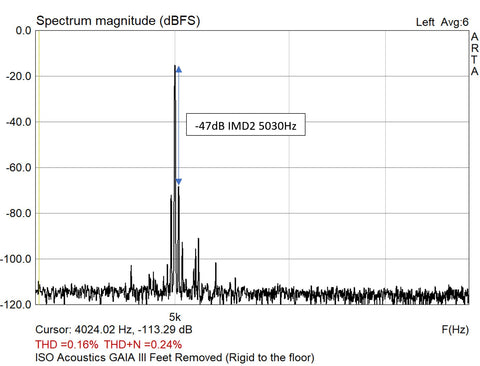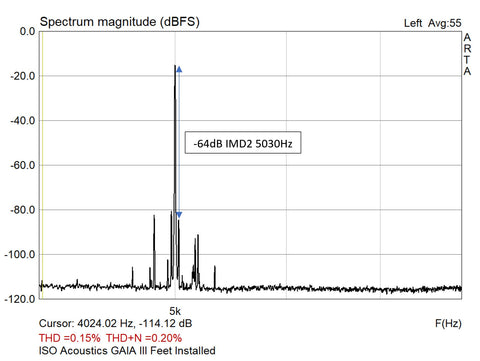
Recently a customer requested ISO Acoustics Gaia III isolation feet for their custom speakers. Once they arrived I was curious to see how they performed and so I devised an objective test to compare the feet against rigidly coupling the speaker to the floor.
My test consisted of subwoofer No.1349 utilizing a single 12" Dayton Audio Reference Subwoofer along with the ES-600 Biradial horn using the SB Acoustics ROSSO 65CDN-T compression driver. The goal here is to modulate the speaker with a strong 95dB F1 tone at 30Hz. With the ES-600 horn placed securely on top of the subwoofer, it plays the F2 tone at 5kHz. The F2 tone is also at the 95dB SPL at 1 meter.
I configured the test so that the F1 and F2 tones were generated using separate amplifiers and tone signal generators. This isolates the electronics from the test. Any resulting intermodulation will be from either the microphone or physical movement of the horn from the subwoofer below it.
I began the test by rigidly coupling the subwoofer to the floor via three hardwood blocks. I confirmed that the subwoofer was indeed rigidly coupled by attempting to rock in in either direction. The subwoofer was secure.
Below is the real time spectrum analyzer of the F2 5kHz tone. To the left and right of the F2 tone we see IMD2 products at 4870Hz and 5030Hz which are -47dB down from the F2 fundamental.

I then installed the ISO Acoustics Gaia lll feet on the the subwoofer and repeated the test. We can see the the addition of the feet reduced the modulation amounts by a significant 17dB.

With the feet installed, the subwoofer physically floats on the feet similar to vehicle suspension. My initial assumption before the test was that the floating effect would have a detriment to midrange and treble clarity due to the low frequency modulation of the cabinet. My test revealed the opposite to be true.
I decided to read the ISO Acoustics literature to find insight into this aspect. According to ISO:
“The reduction in vibrations can be explained by the way that IsoAcoustics isolation manages the energy of the speaker to reduce internal reflections. The vibrations when spikes are used is greater in comparison because the vibrations are hitting the solid surface and conducted back to create internal reflections.”
To clarify, the term “internal” is referring to the entire speaker cabinet mechanically vibrating as a whole, and not the internal acoustical vibration inside the cabinet.
With my hand placed on the top of the subwoofer cabinet, I can confirm that the subwoofer was modulating (physically vibrating) less with the Gaia III feet in place as compared to rigidly coupled to the floor. This was perplexing to me, however after reading the ISO Acoustics literature, the diagrams below help explain. 

Conclusion
From a subjective sound quality standpoint, the reduction in nonlinear distortion would certainly pay dividends on midrange and treble clarity.
From a functional standpoint, the feet not only suspend the cabinet, but they also serve to mechanically damp energy from the physical movement of the speaker as a whole.
So, at least with this objective test, I can highly recommend the Gaia III isolation feet.
